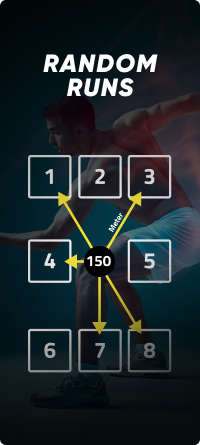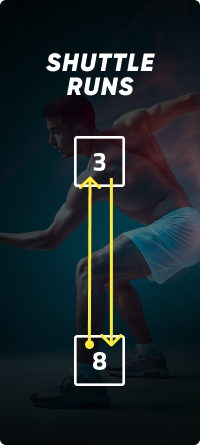Agility
TRAIN YOUR AGILITY WITH
THE SKILLCOURT
imagine you
can…
…be more
agile.
Then
you
are…
Movable
Switch immediately and be one step ahead of your opponent.
Mobile
Maintain your mobility well into old age.
Coordinated
Control your movements and paths precisely.
Fast
React quickly to information around you.
what is agility?
Defin
ition
Agility describes the ability to quickly perceive information in the environment (usually visual), process it and convert it into a motor action. In addition to cognitive and sensory components, muscle strength also contributes to agility.
Agility is crucial in sport when athletes have to react to situations in the game by changing their running direction within a very short time. But good agility also helps in everyday life to carry out movements in a targeted and safe manner and to react to dangers in a timely manner.


agility throughout life
Develo
pment
If agility is not trained, it decreases with age. The reason for this is a reduction in visual and cognitive abilities but also the loss of muscle strength and the ability to balance. With increasing age, reactions become increasingly slower and motor actions become more unstable. The risk of accidents and especially falls increases with age.
Agility training can counteract this development and maintain health and independence well into old age. Athletes also benefit from faster actions and reactions on the pitch to literally be one step ahead of their opponent.
Agility can
be trained
on the SKILLCOURT
To improve agility, the SKILLCOURT offers a variety of general and sport-specific training. Sport-specific agility exercises are based on situations and running routes of different sports and can also be carried out with a ball.
General agility training requires different forms of changing direction, as they also occur in everyday life. In addition, the SKILLCOURT differentiates between planned and reactive agility training. During planned agility exercises, the running routes are known and the training primarily focuses on the physical component of agility performance. Reactive agility training requires the reaction to an external stimulus and increases the demands on sensory and cognitive abilities. This means the training can be selected specifically for the training goal. Different performance tests enable regular monitoring of training progress.
Agility
exercises
on the SKILLCOURT
A special category for agility training has been developed on the SKILLCOURT. Various games enable general or sport-specific training of planned or reactive agility. In addition, some exercises can also be carried out with a ball. Agility exercises on the SKILLCOURT include:
Testim
onials

Training on the SKILLCOURT has increased my mobility enormously. The varied exercises improved my coordination and agility. I notice the difference not only in sport, but also in everyday life.
– Nadja L.

As a dancer, agility is essential for me. The SKILLCOURT has taken my training to a new level. The dynamic exercises have enormously improved my mobility and speed.
– Sabrina K.

The SKILLCOURT is a game changer for my training. The exercises significantly improved my mobility, coordination and reaction time. The playful approach in particular motivates me again and again!
Ready to implement SKILLCOURT?
Are you interested in the SKILLCOURT and would like more information
on how you can integrate the training into your facility?
FA
Qs
What is meant by agility?
Agility is the ability to perceive, process information and convert it into a targeted motor action within a very short time. Both sensory (mostly visual), cognitive and physical (especially muscle strength) components contribute to agility performance.
How can I improve agility with SKILLCOURT?
The SKILLCOURT offers the right agility training for every training goal. Whether planned or reactive agility, sport-specific or general, with or without a ball. SKILLCOURT training adapts to your needs to achieve optimal training results.
Which SKILLCOURT exercises are suitable for improving agility?
The SKILLCOURT includes a variety of agility drills for sport-specific movements. When it comes to changing direction and reactive agility, the “Random Run” and “Random Run Plus” with higher demands on visual and cognitive functions are ideal.
– Figure Run
– Star Run
– Random Run
– Sport Drill
– Shuttle Run
What advantages does increasing agility with SKILLCOURT bring in daily life?
In everyday life, in road traffic and in sports, we have to adapt our movements to changes in the environment at lightning speed. The better our agility is developed, the safer we act in everyday life, the more independent we are as we get older and the better we perform on the pitch.
What factors influence agility over the course of life?
Agility is influenced by perception and cognition skills as well as muscle strength. All components decline with age, which leads to impaired agility. With targeted training, the SKILLCOURT can counteract this loss of performance.
Join our
Comm
unity
Do you want to find out more and not miss anything? Then follow us on our social media channels, or sign up for our latest newsletter. Become part of the SKILLCOURT community today!
Ready
for
SKILLCOURT?
If you're ready to offer SKILLCOURT at your facility or to find out more then simply complete the contact us form and we will be in touch!



